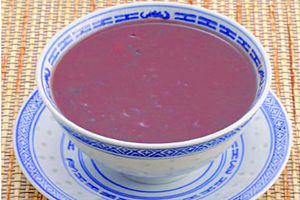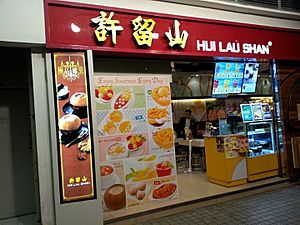Tong sui facts for kids
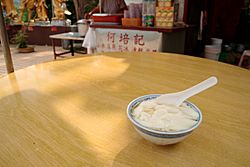
Tofu tong sui at 10,000 Buddhas Monastery
|
|
| Type | Soup or custard |
|---|---|
| Course | Dessert |
| Place of origin | China |
| Tong sui | |||||||||||||||
|---|---|---|---|---|---|---|---|---|---|---|---|---|---|---|---|
| Chinese | 糖水 | ||||||||||||||
| Literal meaning | sugar water | ||||||||||||||
|
|||||||||||||||
| Tian tang | |||||||||||||||
| Chinese | 甜湯 | ||||||||||||||
| Literal meaning | sweet soup | ||||||||||||||
|
|||||||||||||||
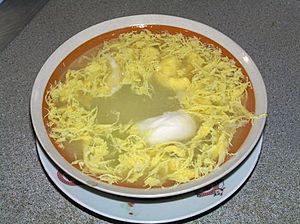
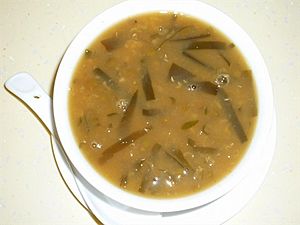
Tong sui (which means "sugar water" in Chinese) is a special kind of sweet, warm soup or custard. It's usually served as a dessert after a meal, especially in Cantonese cuisine. You'll find many different kinds of tong sui in areas where Cantonese is spoken, like Hong Kong and Macau. These sweet soups are a unique part of Cantonese food and are not as common in other parts of China.
In places like Hong Kong, Macau, and Malaysia, there are even special shops just for tong sui! These shops have also become popular in other countries where many Chinese people live, such as Canada, Australia, and the United States.
The History of Tong Sui
Tong sui shops in Hong Kong first became popular after the 1950s. People who moved to Hong Kong from different parts of China brought their favorite sweet soups with them. For example, red bean soup came from Guangzhou, and tang yuan (sweet rice balls) came from Shanghai. These sweet treats were sold in small food stalls and Chinese tea houses.
From the 1980s to the 1990s, Hong Kong's economy grew a lot, and people's lives became more comfortable. New desserts from Western countries also arrived in Hong Kong. This led to new kinds of tong sui being created, often using fresh fruits, like tapioca pudding. Some traditional Chinese herbal tea shops, like Hui Lau Shan, even started selling tong sui too!
Today, in the 21st century, you can find many chain tong sui shops. They are so popular that the Hong Kong Tourism Board often suggests them as fun places for tourists to visit.
Traditional Tong Sui Dishes
Traditionally, tong sui is made with simple ingredients like beans, milk, and fruits. The menus at older tong sui shops mostly feature classic Chinese sweet soups. Some common examples you'll find are red bean soup and sweet almond soup. These are still very popular today!
Popular Varieties of Tong Sui
Here are some of the many delicious types of tong sui you might find:
| English name | Chinese name | Description |
|---|---|---|
| Black sesame soup | Chinese: 芝麻糊; Jyutping: zi1 maa4 wu4*2 | This soup is made from ground black sesame seeds, cooked with water and sugar. It has a rich, nutty flavor. |
| Doufuhua | Chinese: 豆花; pinyin: dòuhuā or Chinese: 豆腐花; Jyutping: dau6 fu6 faa1 | This is a very soft tofu pudding, often served with a sweet syrup. |
| Egg tong sui | simplified Chinese: 鸡蛋糖水; traditional Chinese: 雞蛋糖水; Jyutping: gai1 daan2 tong4 seoi2 | A sweet soup that includes cooked eggs, popular in Hong Kong and southern China. |
| Got fan soup | simplified Chinese: 葛粉汤; traditional Chinese: 葛粉湯; Jyutping: got3 fan2 tong1 | A soup made from kudzu starch, which gives it a thick texture. |
| Guilinggao | Chinese: 龜苓膏; Jyutping: gwai1 ling4 gou1 | A dark, slightly bitter jelly that is often served with a sweet syrup. |
| Purple rice porridge | Chinese: 紫米露; Jyutping: zi2 mai5 lou6 | A dessert made from thick, boiled black rice mixed with coconut milk. It often has sago, red beans, or taro added. |
| Red bean soup | simplified Chinese: 红豆汤; traditional Chinese: 紅豆湯; pinyin: hóngdòu tāng or simplified Chinese: 红豆沙; traditional Chinese: 紅豆沙; Jyutping: hung4 dau2 saa1 | A sweet soup made from red beans, cooked until they are soft and creamy. |
| Sai mai lo or Sago | Chinese: 西米露; Jyutping: sai1 mai5 lou6 | A dessert soup with small pearl tapioca, coconut milk, and evaporated milk. |
| Mung bean soup | simplified Chinese: 绿豆汤; traditional Chinese: 綠豆湯; pinyin: lǜdòu tāng or simplified Chinese: 绿豆沙; traditional Chinese: 綠豆沙; Jyutping: luk6 dau6 saa1 | Made from mung beans, similar to red bean soup, sometimes served with seaweed. |
| Six flavors soup | simplified Chinese: 六味汤; traditional Chinese: 六味湯; pinyin: liùwèi tāng | A sweet soup with six different ingredients, often enjoyed in hot weather. |
| Peanut paste soup | Chinese: 花生糊; pinyin: huāshēng hú | A thick, smooth soup made from ground peanuts, sugar, and water. |
| Steamed egg custard | simplified Chinese: 炖蛋; traditional Chinese: 燉蛋; Jyutping: dan6 daan2 | A soft, sweet custard made from steamed eggs. |
| Steamed milk custard | simplified Chinese: 炖奶; traditional Chinese: 燉奶; Jyutping: dan6 naai5 | A smooth, creamy custard made from steamed milk. |
| Sweet potato soup | Chinese: 番薯糖水; Jyutping: faan1 syu4 tong4 seoi2 | This soup features peeled sweet potatoes, cut into pieces and boiled with sugar and water. |
| Sweet almond soup | Chinese: 杏仁糊; Jyutping: hang6 jan4 wu4 | A creamy soup made from ground almonds, sugar, and water. |
| Sweet walnut soup | Chinese: 核桃糊; Jyutping: hat6 tou4 wu4 or Chinese: 合桃糊; Jyutping: hap6 tou4 wu4 | A sweet, thick soup made from ground walnuts, sugar, and sometimes milk. |
| Tofu skin egg tong sui | simplified Chinese: 腐竹鸡蛋糖水; traditional Chinese: 腐竹雞蛋糖水; Jyutping: fu6 zuk1 gai1 daan2 tong4 seoi2 | This soup includes tofu skin, eggs, sugar, and water. Sometimes ginkgo nuts are added. |
See also
 In Spanish: Tong sui para niños
In Spanish: Tong sui para niños



